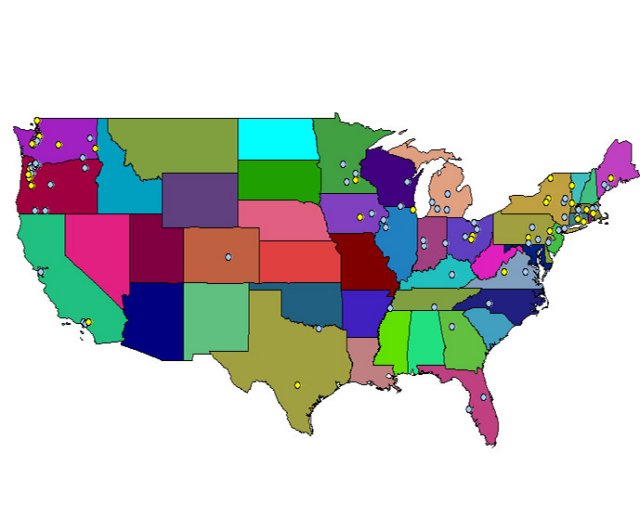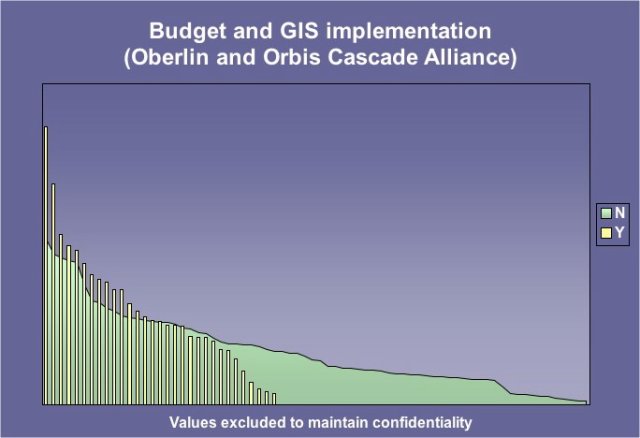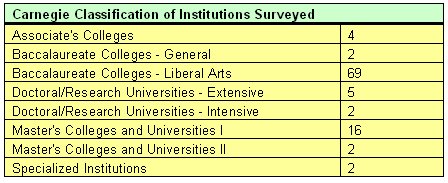GIS and the Academic Library: A Survey of Libraries Offering GIS Services in Two Consortia
Western Oregon University
Monmouth, Oregon
gabaldonc@wou.edu
John Repplinger
Willamette University
Salem, Oregon
jrepplin@willamette.edu
Abstract
This paper summarizes the results of a survey of academic libraries in two consortia (the Orbis Cascade Alliance and the Oberlin Group) to determine the extent of Geographic Information Systems (GIS) implementation and characteristics of libraries that had implemented these services. Of the 103 libraries surveyed, 31 had already implemented GIS services and an additional 15 were considering its implementation. There were significant differences in the implementation rate between public and private institutions. Average materials budget was also higher for those libraries that had implemented GIS than those that had not.
Geographic Information Systems (GIS) has provided users with new ways to process, analyze, and present information, resulting in a new era of spatial information management. According to Wikipedia (2006), GIS is a technology that "integrates, stores, edits, analyzes, and displays geographically-referenced information." The combination of a graphical display and its associated datasets in an interface that allows for manipulation has had an impact across almost every discipline, from the obvious, such as geography, to less likely fields such as the humanities. The ability to display physical attributes so that they are associated with their spatial locations has changed not only the way in which the attributes can be viewed, but also the opportunities available for analyzing them and for creating new connections. This is particularly important for the university library, which serves as an information hub for the entire campus and must maintain an interdisciplinary collection that provides relevant information to all of its users, regardless of their academic discipline.
Both authors of this article have an active interest in GIS, inspired by previous coursework and influenced by exposure to GIS in library settings. Currently, each of our libraries is either considering or offers some level of GIS, so both of us are interested in the possibilities and the pitfalls. By creating a dataset of the libraries in our consortia that are interested in GIS, we are establishing the basis for support and mutual collaboration on a broad scale.
GIS is a natural example of how libraries are using existing and new data to help their users find information. It has been a reoccurring topic in librarianship for more than a decade, yet much of the discussion on this topic focuses solely on the complexity of implementing this service. With this focus in the literature, we were curious about the common characteristics of libraries that have chosen to implement this service.
This article is the result of a survey of libraries in two academic library consortia, the Oberlin Group and the Orbis Cascade Alliance, to determine which libraries have implemented or are considering implementing GIS, and to identify similarities and differences between them. We examined characteristics such as size, materials budget and type of institution (public or private). We then compared GIS services offered and searched for trends or characteristics of libraries offering GIS.
Literature Review
Since the 1960s a movement towards digitization has been underway in libraries worldwide (Boisse and Larsgaard 1995). Digital access has not only made information easier to obtain, but it has also opened up new ways for using information (often acquired as maps or tables) that is already in library collections. GIS has been a good example of how libraries are using existing and new data to help their users find information. GIS began appearing in academic libraries during the 1980s, but it truly began to be a part of library services when the 1990 census materials were given to depository libraries as TIGER (Topologically Integrated Geographic Encoding and Referencing) files. This was followed shortly by a variety of other government data that was distributed by other agencies as part of the depository program (Abbott and Argentati 1995). Since that time, applications for and use of GIS has blossomed in academic libraries. GIS has moved from being a tool used mostly by map or document libraries, to being a tool that can be used by reference librarians to meet the needs of any number of disciplines.The adoption of GIS into regular library services has been slow in non-research libraries. This is partially due to the steep learning curve associated with much of the GIS software. From a usability perspective, it is much more labor intensive for the average user (including librarians) than books, maps or even text-based databases (Abbot and Argentati, 1995). It is common for library patrons to use a resource that they have never used before, but the familiar interface of a book or map allows them to be somewhat self-sufficient. The same is true even of many text-based databases, which have similar interfaces to many typical Internet search engines. With these, the user's information gathering techniques may improve with assistance from the library staff, but it is likely that they will have at least some level of success in navigating the material on their own. With GIS, only the few library patrons that have had GIS experience are likely to obtain any level of success without intervention by library staff (ARL 1999). The intervention often goes beyond teaching techniques or providing a new direction for approaching the problem, as is likely to be the case with a traditional reference source. It often will first involve explaining what GIS is, then teaching the user the basics of using the GIS software, helping the user to locate appropriate data and finally following through with technical expertise for manipulating the data and combining components to create a map.
Until the last decade, hardware and training costs were often prohibitive for all but the largest research institutions. Some of the cost barriers have been reduced, due partially to efforts by industry leaders, such as Environmental Systems Research Institute (ESRI), who have created inexpensive programs to make GIS accessible to schools and libraries (Buckley and Phoenix 2000; Frazer 2001). The literature suggests that larger and well-funded institutions have been able to overcome these barriers by hiring full-time staff to work with students and faculty, and to collect data and data sources. Smaller schools have opted for either limited GIS services or no service at all.
In 1999, 89% of the libraries responding to an ARL (Association of Research Libraries) survey supported GIS services through the library (ARL 1999). The high number of libraries offering GIS services is likely due at least partially to the 1992 ARL Geographic Information Literacy program, which offered libraries and librarians the opportunity to receive training and guidance in the use and teaching of GIS in the 1990's (ARL 1999).
Since the appearance of the ARL report, there has been a notable decline in the discussion of GIS in library literature (Martindale 2004). Particularly, there has been little discussion of the rates and kinds of implementation among libraries. Recent publications have focused more on uses for GIS and tips for GIS librarians without discussion of the kinds or number of libraries that are implementing it (Martindale 2004).
Until May 2005, there was nothing in the literature quantifying or characterizing libraries that had implemented GIS. Kinikin and Hench (2005a) did a survey of more than 230 Carnegie Classification Master's Colleges and Universities I & II in the fall of 2001. They determined that only 13% of the 168 respondents supported GIS in their libraries. An additional 16% indicated plans to implement this service in the future, while more than 70% indicated no plans to implement GIS services. They did predict, based on the number of institutions planning to implement GIS, that the number of institutions offering GIS has the potential to double within 5-10 years.
Methods
The following e-mail survey was sent to each library in the Orbis Cascade Alliance and Oberlin Group: Does your library or another library on your campus have computers with GIS software? If not, are there any considerations to bring GIS software into your library or another library on campus? We used two preexisting private e-mail lists for the survey, the Alliance Science e-mail list for the Orbis Cascade group (alliance-science@lists.uoregon.edu) and the Science e-mail list for the Oberlin Group (obesci-l@willamette.edu), to target a recipient who was likely to either answer the question or pass it along to someone who could (Figure1). The Alliance Science list consists of public and private institutions of various sizes, all of which are located in Oregon or Washington. The Oberlin Science e-mail list is composed entirely of private liberal arts colleges throughout the United States.

Figure 1. Distribution of all institutions surveyed. Yellow indicates that the library is offering GIS; blue indicates that the library is not.
The majority of the recipients were either science librarians or general reference librarians. Some institutions only offered general contact information. There was a healthy response via e-mail, but not a 100% response rate. Institutions that did not respond to the first e-mail were sent a second e-mail, followed by a series of phone calls, which eventually resulted in 100% participant response for both the Orbis Cascade Alliance and the Oberlin Group. Several of the responders provided additional information, which was noted, but not necessarily incorporated in the discussion of the results. We collected additional information after the survey was complete to compare institutional characteristics: location (state & region--by time zone), private versus public institutions, number of full-time (FTE) undergraduate students, annual library expenditures per year (specific numbers not available for public distribution), annual library expenditures per student, (specific numbers not available for public distribution).
After entering all of the information into a series of Excel spreadsheets, statistical analysis (t-test and Chi squared) was done and charts were then created with the data.
Results and Discussion

Table 1. Results for both Orbis-Cascade and Oberlin surveys in 2005.
Our overall survey results of 103 institutions (there was an overlap of 3 institutions between consortia) show that 31 libraries have implemented GIS, 15 are considering GIS, and 57 have no plans to implement GIS (Table 1). When compared to previous surveys, we found that there is a trend in libraries toward implementing GIS. While one of the consortia examined is located in the Pacific Northwest, the other is national and allowed us to examine the implementation trends by United States region. No significant difference was found between regions.
There were noticeable differences between public and private institutions. Fifty percent of the public institutions surveyed indicated that they had implemented some form of GIS, while only six percent of the private institutions had, indicating that public institutions might be more likely to have implemented some form of GIS. This result could be skewed, however, as there were only 16 public institutions included in the survey, compared to 87 private institutions.
The two groups (Orbis Cascade Alliance & Oberlin) were nearly identical in the percentage of institutions that had implemented GIS; there was only a 1% difference between them. Physical location is not a factor in regards to libraries providing GIS. Our statistics indicate that GIS implementation is roughly the same throughout the nation.
Materials budget and library expenditure per student seem to have a strong influence on whether or not a library has implemented GIS; institutions that have large budgets are able to afford the purchase of GIS software and to pay for training and support (Figure 2). Statistical analysis showed that there is a significant difference in budget for the groups with GIS (mean= $3,142,150) and without (mean=$2,144,546). The graph of institutional budgets below indicates that institutions with large budgets tend to be the ones that support GIS.

Figure 2. Institutions with or without GIS according to their budget.
Size and Carnegie classification also seem to be indicators of whether an institution is likely to have implemented GIS; they did not, however, necessarily follow an upward trend. Eighty-six percent (6) of the Doctoral (Intensive and Extensive) institutions surveyed offered GIS. Of the Masters (I & II) institutions, only 21% (4) were offering GIS. There was an increase in GIS offerings among the Baccalaureate (General and Liberal Arts) institutions, with 29% (21) offering some form of GIS in their libraries.

Table 2. Institutions surveyed by Carnegie classification.
While our study covered a wider variety of institutions than those examined by Kinikin and Hench (2005a), it is interesting to see how the numbers changed between our data gathering periods. Kinikin and Hench found only 13% of the libraries that they surveyed offered GIS when they gathered their data in the fall of 2001. Our data gathering was done primarily in early 2005 (just over 3 years later) and we found that more than 28% (31) of the libraries that we surveyed offered GIS software. While the groups in our survey and those in Kinikin and Hench's were selected differently, our results still correlated with each other. Our numbers show an increase in the number of libraries offering GIS, implying that Kinikin and Hench's prediction of growth was correct.
There may be several variables influencing the larger percentage of institutions incorporating GIS in our study. One important variable may be the different Carnegie levels of the institutions that we studied. Our study was primarily Baccalaureate Colleges (68%), while Kinikin and Hench studied Master's Colleges and Universities I & II. This group only makes up 19% of the institutions that we examined, though 21% of those institutions have implemented GIS, still showing an increase in the number of libraries offering GIS. This indicates that even though the follow-up group studied later by Kinikin and Hench (2005b) showed some attrition, the trend overall is still toward implementation.
Another component that was not specifically addressed in our research and could have potential impact on the data was the consortium memberships of the institutions that we surveyed. Membership in a consortium typically allows increased purchasing power for libraries through pooled resources and may enable them to stretch their limited budget further. Budget was listed by many in the ARL survey as a barrier to offering GIS services. The large number of libraries with GIS in our survey might have GIS through consortia agreements, since our survey focused specifically on consortia groups. A comparison of GIS in libraries with and without consortium agreements may be an area for future study.
Conclusion
In summary, our findings indicate that GIS continues to be implemented in academic libraries, and this trend will continue. Physical location is not a factor in terms of libraries implementing GIS; this trend is occurring throughout the nation. Public colleges are far more likely to have GIS, as opposed to private colleges. Libraries with larger budgets and institutions with Doctorial or Masters Programs are more likely to have GIS.As the library makes decisions to implement GIS, there are still potential barriers to overcome. Among these is a need for trained and experienced library staff. GIS is not geared toward novice users, and specialists are needed. Ongoing training is necessary to keep up with changing standards and technology. Regular use of existing software is essential to providing quality GIS service to library users; without practice these skills diminish over time (Frazer 2001). Larger institutions are busier GIS service points, and may have greater need and ability to employ GIS specialists, but it is still important for smaller institutions to provide training to librarians that are taking on GIS as additional responsibilities.
Since GIS is an expensive resource, not all institutions can afford it. In addition to GIS software that can cost several thousands of dollars, datasets for purchase can be pricey, and GIS training frequently costs a minimum of a few hundred dollars. Our surveys indicate that libraries with large budgets tend to have GIS. Institutions with smaller budgets must decide where GIS falls in their list of priorities, and consider the needs of their communities. It is not surprising that in this era of tightened library budgets that the value of GIS would be carefully considered, and that it would have to vie against other library needs.
There needs to be more campus-wide understanding of GIS and the need for it. While we were conducting our survey, a number of conversations involved the description of GIS to other professional librarians. Clearly there is a community of information professionals who are unaware of GIS, let alone the potential use. While there may be little demand for GIS at these campuses, the information professionals should probably be aware of these resources. As the demand for visual information continues to rise, despite the various barriers, libraries will continue to implement GIS software and services.
References
Abbott, T. and Argentati, C. 1995. GIS: A new component of public services. The Journal of Academic Librarianship 21(4): 251-256.Association of Research Libraries (ARL). 1999. The ARL Geographic Information Systems literacy project. Spec Kit 238. Washington, DC: Association of Research Libraries.
Boissé, J. and Larsgaard, M. 1995. GIS in academic libraries: a managerial perspective. The Journal of Academic Librarianship 21(4): 288-291.
Buckley, A. and Phoenix, M. 2000. Organizing an ESRI statewide site license, the Oregon experience. Presented at the ESRI User Conference, San Diego, CA.
Frazer, S. 2001. Are geographic information systems (GIS) a feasible service option for non-research libraries? College & Undergraduate Libraries 8(2): 1-16.
Kinikin, J. and Hench, K. 2005a. Survey of GIS Implementation and Use within Smaller Academic Libraries. Issues in Science and Technology Librarianship 42. [Online]. Available: http://www.istl.org/05-spring/refereed-1.html [Accessed: August 15, 2006].
________. 2005b. Follow-up Survey of GIS at Smaller Academic Libraries. Issues in Science and Technology Librarianship 43. [Online]. Available: http://www.istl.org/05-summer/article1.html [Accessed: August 15, 2006].
Martindale, J. 2004. Geographic Information Systems Librarianship: Suggestions for Entry-Level Academic Professionals. The Journal of Academic Librarianship 30(1): pp 67-72.
Wikipedia. 2006. Geographic Information System. [Online]. Available: http://en.wikipedia.org/wiki/Gis [Accessed: August 15, 2006].
| Previous | Contents | Next |
